Introduction
Impressionism is a French painting movement from the 19th century that illustrated life, movement, nature, and spontaneity. It revolutionized the ways artists painted outdoors at the time and remains still to this day one of the most well-known and influential artistic movements of the past few centuries.
In this pedagogical dossier, we will first introduce you to the origins of the movement, providing a brief historical and cultural context to its rise. Then, we will go into details about the specifics of the movement, based on colors, shapes, brushstrokes, perspective and more. Lastly, we will introduce you to 10 of the most famous Impressionist paintings over the 19th century and provide 2 practical example of activities that can be implemented for an art workshop based on Impressionism.
To summarize, in this dossier, you will:
- Learn the origins of the Impressionist movement,
- Discover some of its key figures and influencers,
- Explore the characteristics of Impressionists’ techniques,
- And more!
The Theme
Background of the movement
Impressionism was a movement rooted in the beauty of light. Although originating in France, impressionism had great influence overseas. Developed by Claude Monet and other Paris-based artists from the early 1860s, impressionists changed the way landscape, and most importantly, light, were painted. Instead of painting in a studio, the impressionists found that they could capture the momentary and transient effects of sunlight by working quickly, in front of their subjects, in the open air – en plein air – rather than in a studio. This resulted in greater awareness of light and colour and the shifting pattern of the natural scene. Brushwork became rapid and broken into separate dabs to render the fleeting quality of light.
The artistic context: the artistic background of the theme, the major artistic questions and issues of the time
Pre impressionism
In the early 19th century, the French painting world was dominated by an institution, The Académie des Beaux-Arts (Academy of Fine Arts). Consisting of a body of 40 elected life members, including 14 painters, 8 sculptors, 8 architects, 4 engravers, and 6 musical composers, the Académie only accepted new members if a previous member died.
Many members of the Académie ran private studios to train students hoping to be admitted to the prestigious École des Beaux Arts, the official art school in France. There, students followed a rigorous curriculum that emphasized on drawing—first after prints and casts, then live models—and included the mastery of composition, perspective, and expression. Most significantly, they chose what hung on the walls of the Salon, the annual exhibitions reviewed by the Parisian journals and attended by the public.
The Académie preferred carefully finished images that looked realistic when examined closely. Paintings in this style were made up of precise brush strokes carefully blended to hide the artist’s hand in the work. Colour was restrained and often toned down further by the application of a golden varnish.

The Académie held every year an art show called ‘Salon de Paris’ where carefully selected artists could display their work to win prizes, commission and increase their prestige and popularity. It was a very prized event to attend.
In the 1860’s, the Salon jury rejected about half of the works submitted by Impressionists (not yet called by that name) in favour of works by artists faithful to the approved style. In 1863, the Salon jury rejected Manet’s The Luncheon on the Grass primarily because it depicted a nude woman with two clothed men at a picnic. While the Salon jury routinely accepted nudes in historical and allegorical paintings, they condemned Manet for placing a realistic nude in a contemporary setting.

The Jury rejected his work, and several others. The large number of paintings rejected that year picked the curiosity of Emperor Napoleon III himself who then decided to allow all the rejected works of 1863 to be published so that the audience could decide by themselves. The event was called “Le Salon des Refusés” (Salon of the Refused). Many of the viewers came to laugh at the paintings, but this marked the beginning of the Impressionist Era.
Impressionism
After trying to organize several other ‘Salon des Refusés’ in the following years without any success, in December 1873, Claude Monet, Auguste Renoir, Camille Pissarro, Alfred Sisley, Paul Cézanne, Berthe Morisot, Edgar Degas and several other artists founded the Société Anonyme Coopérative des Artistes Peintres, Sculpteurs, Graveurs (“Cooperative and Anonymous Association of Painters, Sculptors, and Engravers”) to exhibit their artworks independently. That same year, they organized a large exhibition where more than 30 artists displayed their artworks.
The exhibition was received with mixed feelings. The critic Louis Leroy wrote a mocking review in the newspaper Le Charivari in which, making wordplay with the title of Claude Monet’s Impression, Sunrise (Impression, soleil levant), he gave the artists the name by which they became known. Derisively titling his article The Exhibition of the Impressionists, Leroy declared that Monet’s painting was at most, a sketch, and could hardly be termed a finished work.
He wrote:
“Impression—I was certain of it. I was just telling myself that, since I was impressed, there had to be some impression in it … and what freedom, what ease of workmanship! Wallpaper in its embryonic state is more finished than that seascape.”

The term Impressionist quickly gained favour with the public. Soon, they were identified by their temperament, spirit of independence and rebellion. The Impressionists’ style, with its loose, spontaneous brushstrokes, would soon become synonymous with modern life.
The Salon of Impressionists was organized 8 times between 1874 and 1886, but its members slowly drifted away from the movement to explore their own style. Indeed, disagreements over who had the right to exhibit with them were common and many artists continued to try and exhibit at the Salon de Paris. Little money was made from the Salon of Impressionists, but they grew a considerable fan base, so much that by 1890, impressionists’ techniques was commonplace.
Post Impressionism
Post-Impressionism was a French art movement that developed roughly between 1886 and 1905, from the last Impressionist exhibition to the birth of Fauvism (See Pedagogical Dossier on Fauvism). Post-Impressionism emerged as a reaction against Impressionists’ concern for the naturalistic depiction of light and colour. The Post-Impressionists were dissatisfied with what they felt was the triviality of subject matter and the loss of structure in impressionist paintings, though they did not agree on the way forward. Although they often exhibited together, post-Impressionist artists were not in agreement concerning a cohesive movement.
Impressionist painters
The principal impressionist painters were Claude Monet, Pierre Auguste Renoir, Camille Pissarro, Alfred Sisley, Berthe Morisot, Armand Guillaumin, and Frédéric Bazille, who worked together, influenced each other, and exhibited together. Edgar Degas and Paul Cézanne also painted in an Impressionist style for a time in the early 1870s. The established painter Édouard Manet, whose work in the 1860s greatly influenced Monet and others of the group, himself adopted the Impressionist approach about 1873.

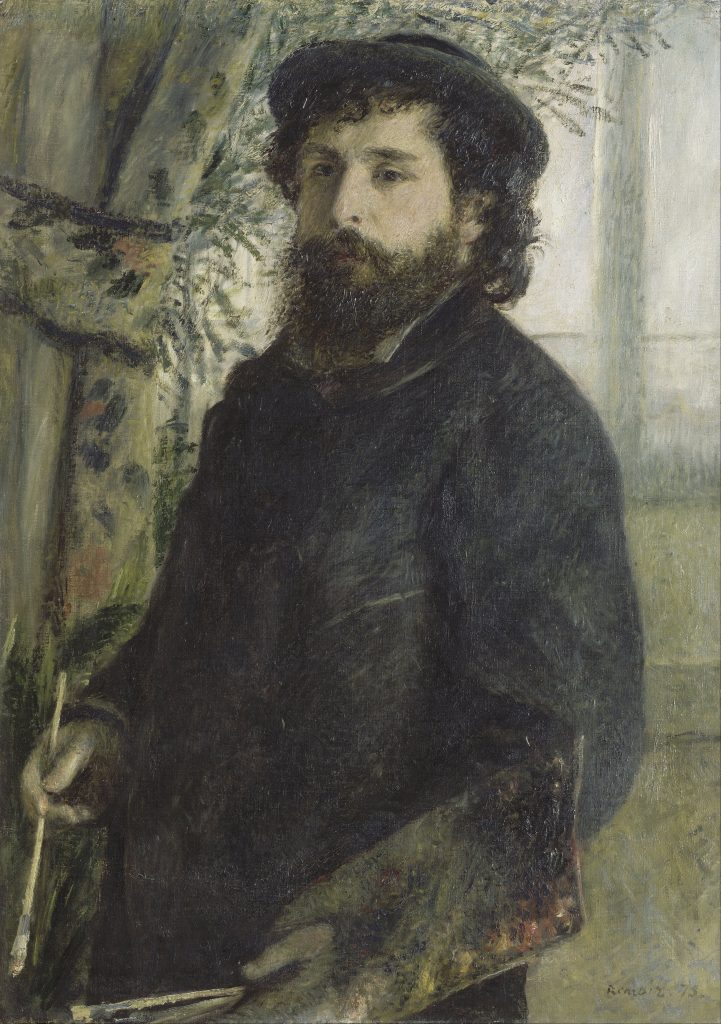
Several women were able to find success during their lifetime, even though their careers were affected by personal circumstances – Bracquemond, for example, had a husband who was resentful of her work which caused her to give up painting. The four most well-known, namely, Eva Gonzalès, Marie Bracquemond, and Berthe Morisot, are, and were, often referred to as the ‘Women Impressionists’.

Historical and societal context of the movement
The industrial revolution and the invention of the railroad suddenly awarded greater leisure time to middle and lower-class Parisians, and a way to travel quickly and inexpensively to the countryside. During this time, around 1860, four young art students – Monet, Sisley, Pierre-Auguste Renoir and Frédéric Bazille – met while studying under French academic artist Charles Gleyre. In their free time, the students began boarding trains bound for remote areas around the city, where they’d set their easels amongst the fields or riverbanks and try their best to capture the fleeting glints of sunlight reflected by water.

Furthermore, impressionist started to paint themes depicting an increasing contrast between labor and leisure in society and contributed to the overall growth in the gap between the working class and middle class. Some of the themes Impressionism tended to emphasize were “productivity, technology, and urbanization.” Although Impressionist artists had already been painting scenes depicting labor and productivity, there were also many naturalistic paintings that would provide the foundation for leisure paintings.
The Impressionists didn’t just focus on men’s labor, either. Edgar Degas was particularly interested in capturing working-class women’s occupations on canvas. Though Degas is most famous for his paintings of ballet dancers (who were commonly known to be sex workers), his paintings offer a compelling portrait of female labor.

Characteristics of the movement
There are several characteristics that can help a viewer identify the traits of an impressionist painting. Here are some of the most common ones:
Color techniques:
Broken colors: Impressionists’ color technique during the 19th century was something called ‘broken color’. This technique was developed by Monet and Renoir, whose idea was to use put the colors directly on the canvas, using small and short strokes, without blending one color with another. The normal method of mixing colors was to blend smoothly one color with another, but impressionists liked the ‘patchwork’ appearance of the ‘broken color’. The technique gave a strong visual effect of light falling over various objects, would allow the viewer to blend the color together ‘themselves’ and show strong contrast and skills.

No use of black: Impressionists were fond of colors, they avoided using black paint altogether. To create shaded areas or darker areas, they would use darker contrasted tone of the typically bright color used. Instead of using black and gray paint to depict shadows, the painters paired complementary colors. Monet said: “Color owes its brightness to force of contrast rather than to its inherent qualities … primary colors look brightest when they are brought into contrast with their complementaries.”
In ‘La Gare de Saint Lazare’ below, Monet used a rich array of browns and grays by combining new synthetic oil paint colors such as cobalt blue, cerulean blue, synthetic ultramarine, emerald green, viridian, chrome yellow, vermilion, and crimson lake. No shadow was considered as being without color, and the deepest shadows are tinged with green and purple.

Impasto painting: The method of using short, thick brushstrokes of colors is called Impasto painting. Impasto allows for volume and depth, where the objects and subjects look like they are part of the canvas.
Wet on wet paint: Painting objects with layers of wet paint without waiting for each stroke to dry is a characteristic of Impressionism. This technique allowed more loose and softer edges, as well as color mixing innovation.

Lighting
Several Impressionist painters devoted entire series of paintings to a single object observed during different times of the day. Monet’s haystacks are a perfect example of a dedication to lighting.
Another characteristic feature of the impressionists is that the light conditions at the given time in day are painted very close to reality for each scene or landscape. This technique provides a great “impression” of the natural light of the moment. The blended colors of the evening, or the bright colors of morning scenes provide a very realistic representation of the conditions in the artwork.
Here are some examples, but Monet painted dozens of ‘Haystacks’ in different lighting.
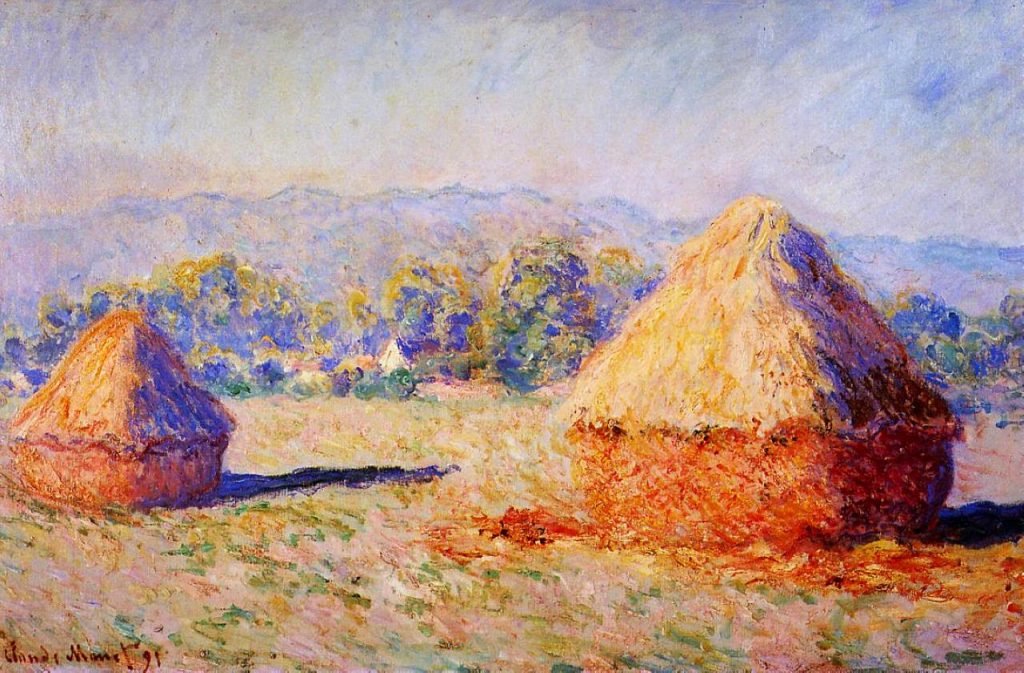

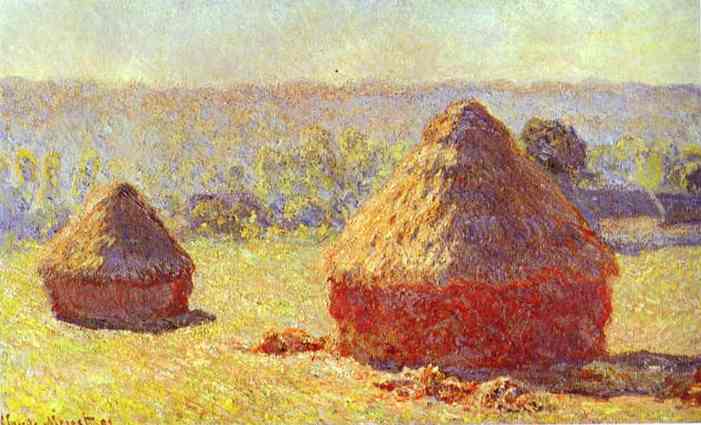
En plein Air
With recent access to pre-mixed paints in tubes, painters were able to move their canvas outside of the studios. Painting ‘en plein air’ – out in the open – added contrast, shadows that were boldly painting with blue skies that reflected onto surfaces, which gave a sense of freshness that was not achieved before in painting. Impressionist painted in sunlight directly from nature and making use of the vivid synthetic pigments that were available they began to develop a lighter and brighter manner of painting.
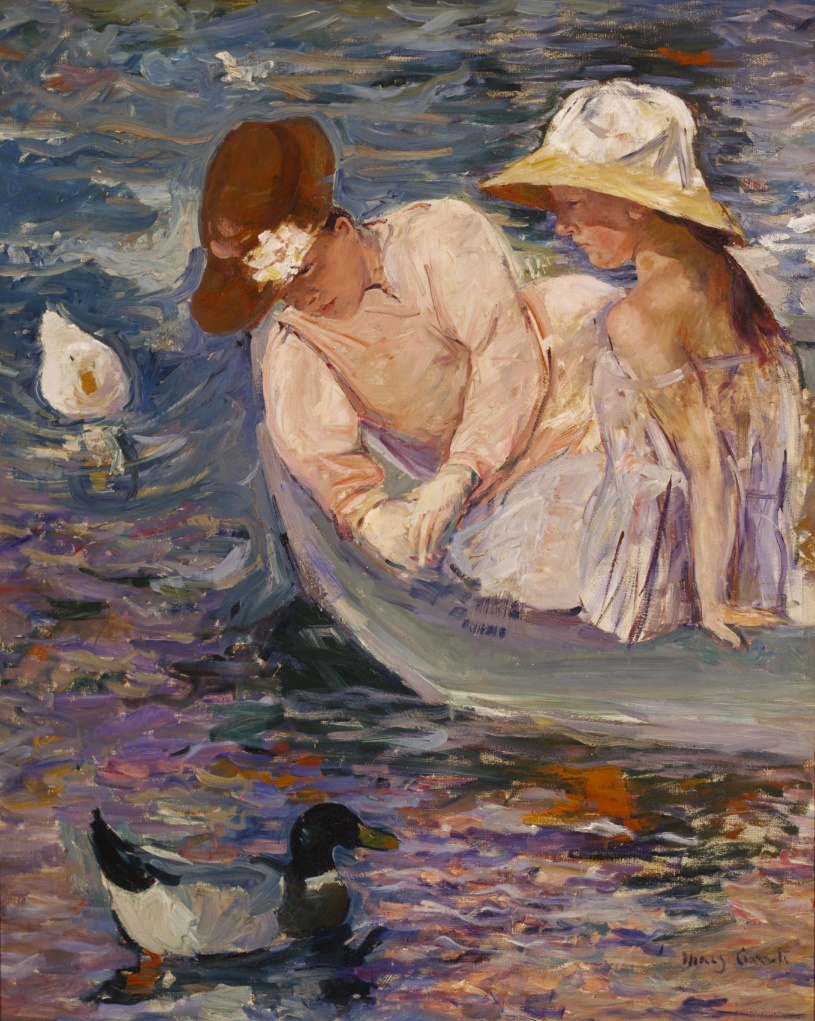
Pedagogical approach
Why is this theme relevant to adult learners?
Impressionism is one of the most recognizable painting movements of the past century. Indeed, artists were prolific and gain popularity quickly. Recently in 2019, a painting by Monet sold at more than $110.8 million! Impressionism has also very specific techniques that are clearly recognizable, which allows for in depth analysis of colors, brushstrokes, lighting and more. As a movement that opened the door to more abstract and less academic or religious painting, it is a turning point in painting history that learners cannot bypass. Indeed, Impressionism is often considered one of the first modern movement in painting.
What are the learning outcomes of embedding this art theme with an educational activity?
With this activity, learners will be able to discover Impressionism through the painter’s tools and eyes. Indeed, the activities are set so that learners can learn the power of light reflecting on objects and how it can influence artistic views.
They will also be able to delve more into specific paintings and watch video explanations of some of the most influential artworks.
How to do it: strategies, tools, and techniques.
Learners will take both an active and inactive participation in their own learning. Indeed, using their cameras they will be able to develop their knowledge of lights, and discuss with the class, then learn from other experts in the fields of art history.
Artworks
Artwork #1 Claude Monet, Impression, Soleil Levant, 1872

- Its position-relation to the theme: Impression, Soleil levant is the name bearer of the entire Impressionist movement. It received the strongest critics when it was exposed and is one of the most important work of Monet’s life.
- Short description: The painting represents a scene early in the morning in The Hague. The harbor is a symbol of the Industrial Revolution as you see the marina with steamboats, smoke, and fog. The loose brushstrokes allow for a ‘feeling’ of the painting rather than a copy of what is depicted.
- Location and European dimension: The painting is exposed at Musée Marmottan Monet, in Paris, France.
- Possible educational exploitation: This painting was quite controversial when it was first made public, it can be interesting for learners to inquire as to the different reaction it created, why they were negative based on societal observation and what and why some people liked it.
Artwork #2 A Sunday on La Grande Jatte, George Seurat, 1884

- Its position-relation to the theme: La Grande Jatte was painted by Georges Seurat, who briefly exhibited with the Impressionists in 1886. He soon moved on to what is today known as Neo-Impressionism, a rebellious form of impressionism. This painting marks the beginning of the Neo-Impressionism movement and the dissidence of Seurat.
- Short description: The painting uses the technique of pointillism, a technique that relies on the ability of the eye and mind of the viewer to blend the color spots into a fuller range of tones. The painting represents a typical Sunday afternoon on the banks of a famous river in Paris where Parisians usually tried to escape the heat and relax.
- Location and European dimension: The painting is located in the Art Institute of Chicago, in the USA.
- Possible educational exploitation: Analysis this painting can help learners discover the Neo-Impressionist movement and explore how Seurat’s work evolved from Impressionism to works such as La Grande Jatte.
Artwork #3 Woman Reading, Edouard Manet, 1879

- Its position-relation to the theme: This painting is Manet’s closest work to the Impressionist style; the quick, free brushstrokes and light colors are characteristic of his technique late in his career.
- Short description: The painting depicts a young woman seated on a cafe who was fashionably dressed, the cafe seems to be outside, yet she remains bundled up. The woman is holding the journal in both of her hands. From the figure, it was not clear that she was reading the journal or using large pages of the journal as a screen to looks at something.
- Location and European dimension: The painting is located in the Art Institute of Chicago, in the USA.
- Possible educational exploitation: Manet’s painting career is not linear within the Impressionist movement. It is interesting to see how his painting of the Luncheon on the Grass allowed for Impressionist to exhibit their paintings at the Salon des Refusés. He is a key and pivotal figure of the change between Realism and Impressionism which is interesting to study.
Artwork #4 Luncheon of the Boating Party, Pierre-Auguste Renoir, 1881
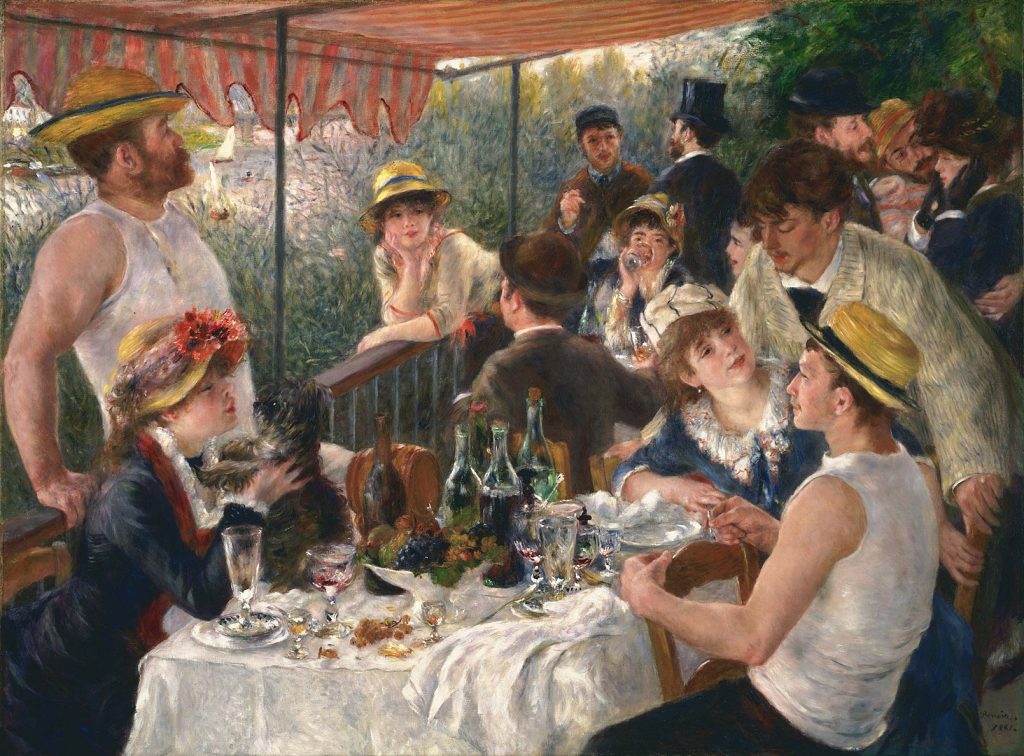
- Its position-relation to the theme: The painting is a perfect illustration of the Impressionist style. It was exposed in the 1882 Salon of Impressionist and received the highest praises.
- Short description: The painting represents some of Renoir’s closest friends and family having lunch on a sunny. For example, the lady holding a dog on the left of the image is Aline Charigot, Renoir’s wife.
- Location and European dimension: The painting is now in the Phillips Collection, Washington DC, USA.
- Possible educational exploitation: Use the image to discover who was close to Renoir as each of the faces represent someone. You can find more information about them here. Use the ‘click to link’ features to explore each face.
Artwork #5 Paris Street; Rainy Day, Gustave Caillebotte, 1877

- Its position-relation to the theme: Paris Street, Rainy Day is Gustave Caillebotte’s most famous work. Caillebotte was a close friend and patron of the impressionist painters, and even if his work is part of that movement, this one is different in its realism and closeness to the lines rather than large brush strokes.
- Short description: The painting is set in a wintery, rainy afternoon where a couple walks underneath an umbrella. The two people in the forefront are fashionable according to Parisian standards and look like they are from the middle class. The foreground is in focus, but slightly smudged; the middle ground has sharp, clear edges and well-defined subjects, and the background fades into the distance, becoming more and more blurry the farther back the eye travels.
- Location and European dimension: The painting is located in the Art Institute of Chicago, in the USA.
- Possible educational exploitation: It is interesting to think about this painting within an impressionist’s eye. What is different? Learners can spot the difference of style and techniques between this painting and his prior drafts for example.
Artwork #6 Water lilies and Japanese bridge, Claude Monet, 1899

- Its position-relation to the theme: The water lilies collection includes more than 250 oil paintings done by Claude Monet. This was his most prolific representation in the last 30 years of his life. Monet’s waterlilies represent the epitome of Impressionism, and some of the most representative works of art of the 20th century they are in exhibition across the world and sell of large sums.
- Short description: In this painting, Monet painted his waterlilies with a Japanese Bridge above it. The tones are complimentary in the blue, green and purples hues. You can also see the broad brushstrokes on the flowers which attract the eye.
- Location and European dimension: The painting is located in the Princeton University Art Museums in the USA.
- Possible educational exploitation: Explore Monet’s prolific series of waterlilies and guide the learners to note the different plays on light and colors that Monet tried to convey in so many attempts. This is a great exercise as Impressionists thrived by working on the different ways in which light plays on objects.
Artwork #7 The Card Players, Paul Cezanne, 1894
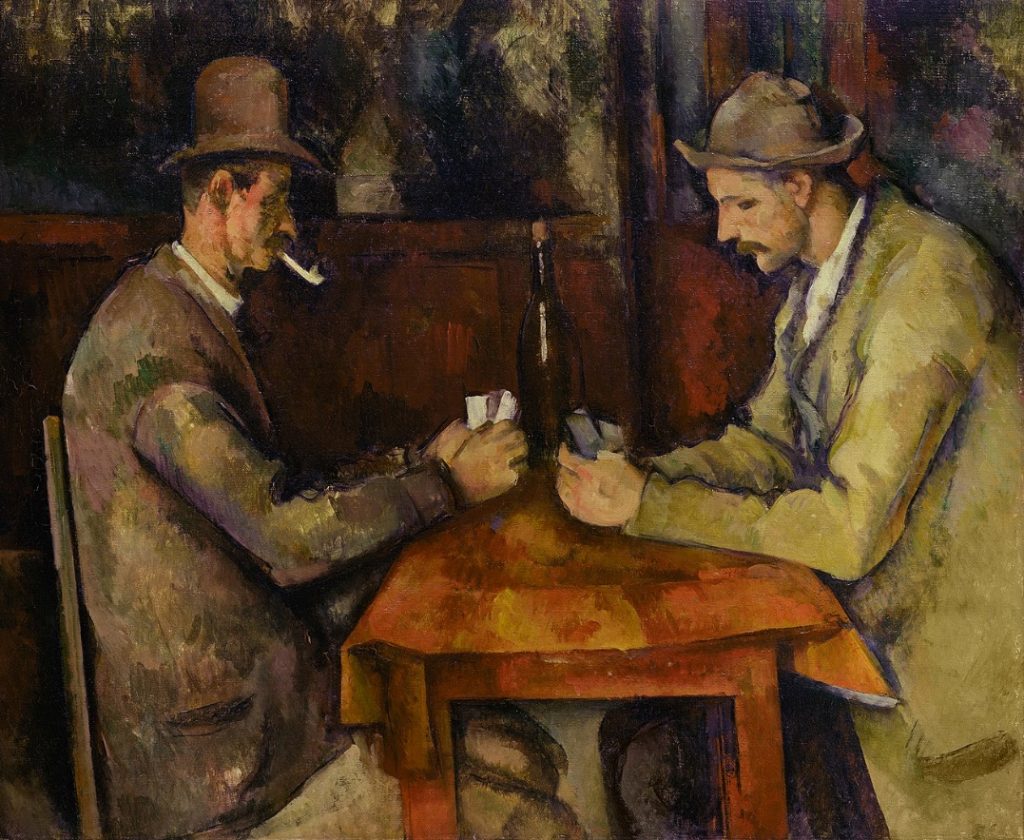
- Its position-relation to the theme: The Cart Players is also part of a series of 5 painting by Cezanne. He painted them in the early 1890, and they represent some of the most prominent genre painting of the French art world. Cezanne was a prolific painter that toed the line of impressionism and post impressionism like no other painter.
- Short description: The painting represents two farmers playing a game of cards. The tones are in the browns but there is almost no use of black, an impressionist trait. He used traits of lilac and green to highlight the painting in thin layers.
- Location and European dimension: The painting is now located in the Musée d’Orsay, in Paris, France.
- Possible educational exploitation: It is interesting to compare this series to Cezanne’s more colorful works of landscape in Provence. A in depth analysis in colors and colors theory could be a good exercise for Cezanne’s paintings.
Artwork #8 The Dance Class, Edgar Degas, 1874

- Its position-relation to the theme: Edgar Degas is well known for depicting ballet dancers in their various form. This artwork represents the most ambition painting of Degas devoted to the theme of dance. The painting was exposed at the 1876 Impressionist exhibition, but Degas never felt that his artworks were too close to the other impressionists.
- Short description: The painting represents Jules Perrot, a conductor who is evaluating a group of ballerinas while their mother watches the lesson.
- Location and European dimension: The painting is located at the Metropolitan Museum of Art in the USA.
- Possible educational exploitation: Degas painted many variations of the Ballerinas and dancers. It is a great way to study movement and how movement was painted by the impressionist. In the painting above, but also in his other artwork.
Artwork #9 The Boulevard Montmartre on a Winter Morning, Camille Pissaro, 1897

- Its position-relation to the theme: Pissaro painted multiple versions of the Boulevard Montmartre, just as many impressionists would do to understand how light changes the way we perceive things. Interestingly, Pissaro was able to observe life from a bird’s eye view from his little apartment, which allows him to really depict Parisian life as he saw it. This outlook was also influenced by the Industrial Revolution.
- Short description: The painting represents the Boulevard Montmartre in Paris, during the winter. Along with the buildings, cars, and people, the atmosphere and lighting are also tangible aspects of the piece. Rather than use clear lines, Pissarro uses colour theory to create a sense of distance.
- Location and European dimension: The painting is located at the Metropolitan Museum of Art in the USA.
- Possible educational exploitation: Pissaro’s work was influenced by Monet, especially in this series. It could be interesting for learners to note the difference in style, brushwork and more to highlight the distinction between the two artists.
Artwork #10 Bal du moulin de la Galette, Pierre-Auguste Renoir, 1876

- Its position-relation to the theme: This artwork might be Renoir’s most important work of the 1870s and probably one of the most important impressionist pieces. It was put on display at the Impressionist Salon in 1877.
- Short description: Renoir painted some of his friends, and the Parisian working class at the Moulin de la Galette in Montmartre. There, people would dance, drink and enjoy themselves. The play on light is especially important as you can see bits of lights from under the trees but also from the lamps above the dancefloor.
- Location and European dimension: This painting is now located in the Musée d’Orsay, in Paris, France.
- Possible educational exploitation: The atmosphere and feeling coming off from the painting are very special. It can be interesting to analyse it comparing it to other paintings of crowds to see how light can make such a big difference.
Practical activities
Activity 1
Name of the activity
Light and time
Aims
To help learners discover why light played such an important role in impressionism painting.
Materials
- A phone with a camera, or a digital camera
If the learners are artists, then they can use their painting materials with an easel.
- A printer or projector
Preparatory stage for educators/mediators
Show the learners Monet’s vast series of Waterlilies or Haystacks throughout the days and seasons. This will help the learners to understand what we are trying to achieve.
This is a multiday activity, so you need to check the weather on the days where learners are out taking their images. The sky needs to be clear with similar sunlight throughout the day.
Development
Ask your learners to select a monument, landscape, element outside that they will have to photograph with the exact same view or perspective each time.
Once they have selected their landscape, set the schedule. One photo should ideally be taken:
- Early Morning (shortly after sunrise)
- Mid-Morning (10-11am)
- Noon (12-1pm)
- Mid-Afternoon (2-3pm)
- Evening (just before sunset)
They can take up to 5 version of the same image in 5 different lighting.
Then, once all learners have taken their differently lit photos, use Monet’s Haystacks or Rouen Cathedral series to compare the images in differently lit scenes.
Think with your classroom of the role of light, how it affects colors, feelings and techniques.
Handouts or practical sheets
N/A
Activity 2
Name of the activity
Follow the Khan Academy
Aims
For learners to discover more specifics about impressionist paintings, techniques and more.
Materials
Access to a computer with an online connection.
Preparatory stage for educators/mediators
The Kahn Academy resources are self-taught. However, the educator can focus on specific videos rather than asking learners to follow everything.
Development
Learners can explore videos about specific paintings and more through this website, and then take a quiz at the end to evaluate their knowledge.
Realism, Impressionism and Post-Impressionism — Khan Academy
